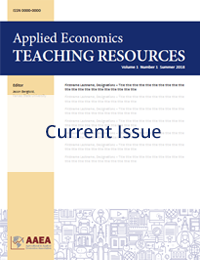Teaching Education Commentary
Reflecting on Using Reflection Exercises to Improve Student Learning and Teaching Effectiveness
Jaclyn D. Kropp (a)
(a)University of Florida
JEL Codes: JEL Codes: A22; A20
Keywords: Experiential learning, Reflective learning, Teaching effectiveness
First Published Online: December 11, 2024
Abstract
In this commentary, I reflect on employing reflection exercises to improve student learning and teaching effectiveness. The theory of reflective learning and the importance of engaging in reflection after active and experiential learning are discussed. I present on overview of the reflection exercises that I employ, which are based on the Respond, Summarize, Vocabulary, Pose a New Question (RSVP) method and Gibbs’ reflective cycle. Reflection assignments allow students to document their learning experience while also providing feedback used to make improvements to the course in real time. The summaries and questions posed by students assist with the identification of topics and concepts that need to be reviewed and remediated. Employing these exercises have increased students’ class attendance, engagement, immediacy, and average course grades as well as my rapport with students and scores on my formal end-of-term course evaluations. Students’ suggestions have led to the deletion of old assignments, creation of new assignments and reorganization of the course material, improving course effectiveness. Students indicate benefiting from engaging in the reflection exercises by feeling more connected to the course material. Students also demonstrate a deeper understanding of the course material.
References
Boud, D., R. Keogh and D. Walker (eds.) 1985. Reflection: Turning Experience into Learning. New York NY: RoutledgeFalmer.
Clemson University. n.d. “Reflection Activities.” Office of Teaching Effectiveness and Innovation. https://www.clemson.edu/otei/documents/Reflection%20Activities%20r.pdf
Emanuel, A. 2020. “Three Reflection Activities for Online Learners.” CALS Teaching Enhancement Symposium, University of Florida, Gainesville FL, August 19.
Eyler, J., D.E. Giles Jr., and A. Schmiede. 1996. A Practitioner’s Guide to Reflection in Service-Learning: Student Voices and Reflections. Washington DC: Corporation for National Service.
Eyler, J., and D. Giles. 1999. Where’s the Learning in Service-Learning? San Francisco CA: Jossey-Bass, Inc.
Gibbs, G. 1988. Learning by Doing: A Guide to Teaching and Learning Methods. Oxford Polytechnic UK: Oxford, Further Education Unit.
Greenaway, R. n.d. “The Active Reviewing Cycle.” https://reviewing.co.uk/learning-cycle/
Kolb, D.A. 1984. Experiential Learning: Experience as the Source of Learning and Development. Englewood Cliffs NJ: Prentice-Hall, Inc.
Mohd Harithuddin, A.S. 2021. “A First Experience of Using Failure Report as a Reflective Tool in Engineering Education.” International Journal of Emerging Technologies in Learning 16(18):23. DOI:10.3991/ijet.v16i18.24271
OpenLearn. n.d. “Four Models of Reflection—Core Concepts for Reflective Thinking.” The Open University, Scotland. https://www.open.edu/openlearn/ocw/mod/oucontent/view.php?id=51386§ion=4
The University of Tennessee Knoxville. n.d. “Reflection Activities. Teaching and Learning Innovation.” https://teaching.utk.edu/wp-content/uploads/sites/78/2018/04/ReflectionActivities.pdf
Articles in this issue
Textbook Review of: Equilibrium Displacement Models: Theory, Applications, and Policy Analysis. By Gary W. Brester, Joseph A. Atwood, and Michael A. Boland
George Davis, Andrew Keller, Henry Kinnucan, Mike McCullough, Hikaru Hanawa Peterson, et al.
Reflecting on Using Reflection Exercises to Improve Student Learning and Teaching Effectiveness
Jaclyn D. Kropp
Innovate to Lead: Curriculum Innovations to Meet Students’ Needs in Applied Agricultural Economics and Agribusiness Programs
Rachna Tewari , Na Zuo, Maria Bampasidou, Anthony Delmond, Lijiao Hu, Tanner McCarty, et al.
Using NetLogo to Build an Agent-Based Model for Teaching Purposes at the Graduate Student Level
Bryan Collins and Chyi-Lyi (Kathleen) Liang
An Ignatian Pedagogical Approach to Fostering Conversations on BIPOC Farmland Ownership Through Film Screenings
Jacquelyn D. Wiersma-Mosley, Trey Malone, Logan G. Moss, and Wendell Scales Jr.
Using Generative Artificial Intelligence to Aid Classroom Retention
J. Ross Pruitt, Anthony R. Delmond, Sandy Mehlhorn, and Diana L. Watson
Engaging Students in Open Dialogue about Use of AI Tools in Economics Courses
Zoë Plakias
Farmland Price-Rent Surveys: Opportunities for Outreach and Teaching
B. James Deaton, Nicholas Bannon, Alexander Scholz, and Jamie Naylor


